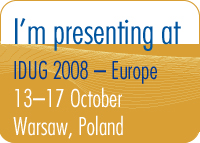IDUG turns the Big D into the Big DB2
 IDUG.org: 2008 North America conference wrap-up
IDUG.org: 2008 North America conference wrap-up
Disclosure: Last week I attended the IDUG 2008 North America conference, not just as an IDUG member, but also as a volunteer on IDUG's conference planning committee, which started organizing the event over nine months ago. If you attended the conference, I and my fellow CPC volunteers probably played some part in your (hopefully positive) experience.
After last year's North American IDUG conference, which somehow managed to be both sprawling and cramped at the same time, it was a relief to find a bunch of Texas-sized rooms situated relatively close together this year. Most of the sessions had fifteen minute breaks scheduled between them, which allowed for a good deal of casual networking given the short distance between most rooms.
As expected, Arvind Krishna's Monday morning keynote provided a detailed state of the union of IBM's holy trinity (DB2, Informix, and IMS). Here are some of the happy numbers I remember:
- DB2 on System z powers 9 of the world's top 10 insurance companies, 23 of the top 25 retailers in the US, and every single one of the top 59 banks in the world.
- Just one IMS customer (presumably one of the bigger ones) handles as much as three trillion dollars in transactions in a single day.
- IMS databases handle transactions for 95% of Fortune 1000 companies
- The sum total of all live data managed right now in IMS is estimated to be over 15 exabytes, or 15 billion gigabytes, served up on over 3 million MIPS of mainframe hardware.
You get the idea. DB2 and IMS are big, they're definitely not going away, but IBM keeps working to improve them anyway. Some of those statistics were repeats from previous DB2 conference keynotes, but I believe they're still worth mentioning. One thing that was all new, though, was Arvind's introduction of IBM's newly-acquired SolidDB product as a memory-resident cache that front-ends DB2. As an old UNIFACE Seven developer from the 1990s, I had mostly good experiences working with older versions of Solid, and I can only imagine it must be even better these days.
Curt Cotner's half of the May 19th keynote focused squarely on IBM Data Studio, which appears to be IBM's sincere attempt to atone for Control Center and a rogue's gallery of other infamous DB2 tools. By building Data Studio on top of the Eclipse integrated development environment (which IBM gave to the open source community a few years ago), DB2 admins and developers have a much more solid foundation for building a decent DBA toolkit. I've been working with it for a little while, and it generally does what I want. If you haven't pulled Data Studio down for yourself yet, I recommend you give it a try.
After four days of solid presentations from DB2 users, I was ready to hear some of the folks from the Toronto Lab share what they could about IBM's DB2 product strategy and drop some hints about the next release (whenever that will be). Tim Vincent from IBM spoke for an hour and a half on best practices for DB2 LUW, and ended with a link to a collection of detailed documents that you will want to check out.
Held immediately after Tim's session on best practices, the LUW panel was as informative as ever, with Chris Eaton serving as emcee/quizmaster. Even when the inevitable long, rambling questions started rolling in from the audience, Chris handled them as well as anyone in that position could. The panelists confirmed the rumors that some future version of DB2 LUW will allow a migrated database to be enabled for automatic storage, which will be a big help to all those DBAs sitting on databases that were rolled in from DB2 V8.1 or older. There was also mention of finally disabling some of Express-C's forbidden features, but judging from the questions IBM was asking the audience, it was hardly a done deal. If such a lock ever materializes, it may just be a voluntary switch that a DBA can flip at will.
Attendance was down a bit from last year's IDUG conference in San Jose (which attracted lots of Bay Area IBMers with single-day passes), but there were plenty of favorable comments coming in from this year's crowd, who came all the way to Dallas just to get their DB2 on. Being a CPC volunteer kept me pretty busy at times, but I was still able to enjoy much of the conference. We ate barbecue, played poker, and some of us really got to know a decent local beer. We renewed our certifications, mocked the robotic livestock, and did whatever we could to get out of line dancing. We didn't know if we'd ever find ourselves in Dallas again, so we did what we could to have a good time while we were there.
Labels: conference, idug


